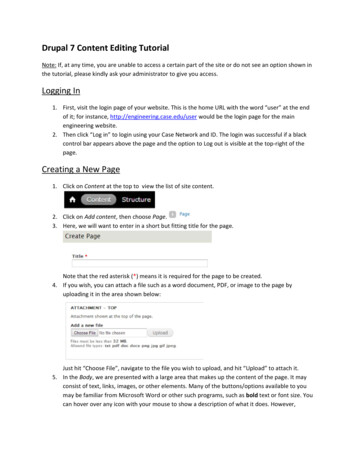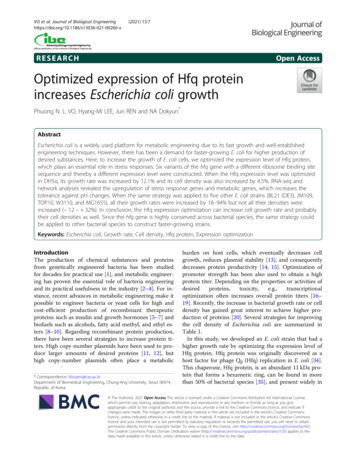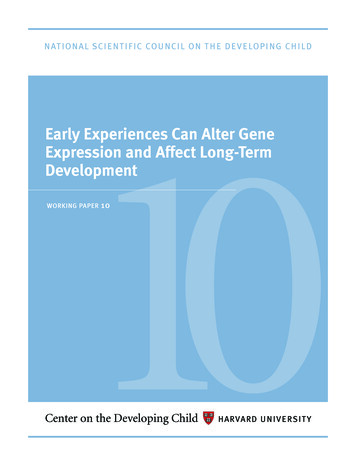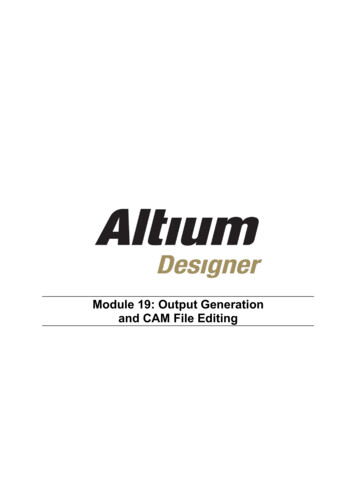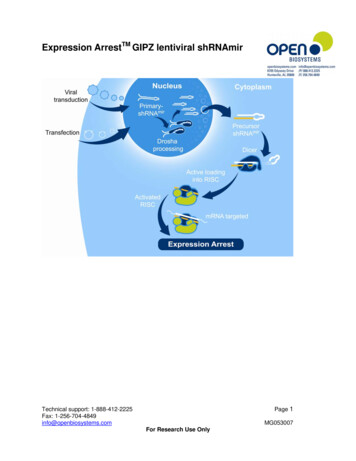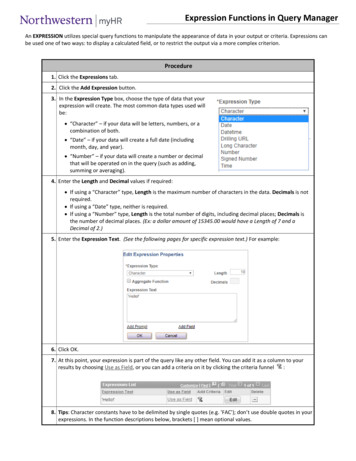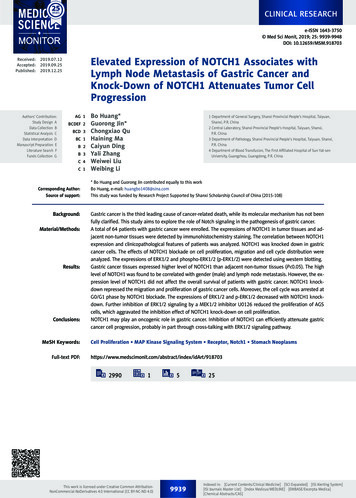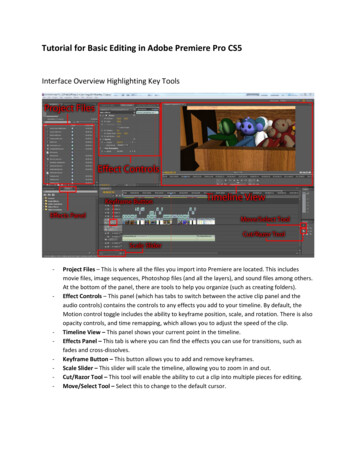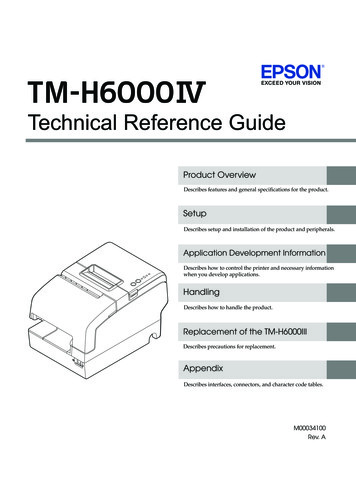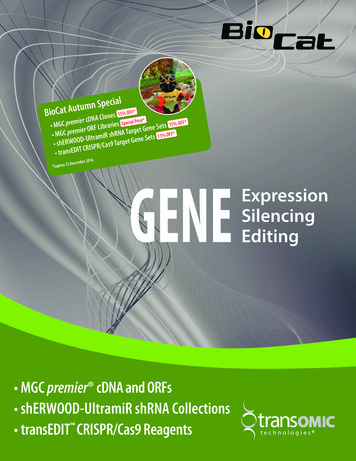
Transcription
pecialSnmutuOFF*BioCat Anes 15%Cloce*mier cDNAOFF*s Special Priiera MGC preribSets 15%LeFnReOGrteiemrgOFF* MGC pre UltramiR shRNA TaSets 15%enDeOGOteWTarg shERISPR/Cas9RCITDEs traner 20165 Decemb*Expires 1ExpressionSilencingEditing MGC premier cDNA and ORFs shERWOOD-UltramiR shRNA Collections transEDIT CRISPR/Cas9 Reagents
MGC premier cDNA and ORFsChoose from Full-Length, Sequence Verified cDNA,Entry ORFs and Tagged ORFsAvailable Options: Mutagenesis Vector Development Lentiviral Cloningand PackagingH Human, M Mouse, R Rat, B Bovine, X Xenopus, Z Zebrafish
Gene ExpressionLargest Collection of Pre-made, Full-Length cDNA and ORFstransOMIC technologies provides you with the highest sequence quality and confidence when purchasing pre-made,full-length cDNA and ORF clones. All inserts have been rigorously sequenced and are backed by a 100% guarantee tobe an exact match to the published sequence. (MGC Project Team, 2009; Yang et al., 2011).MGC premier cDNAcDNA clones include the open reading frame and untranslated regions (UTR)Sequence guaranteedIdeal for native protein expressionHuman, mouse, rat, bovine, Xenopus and zebrafish genomes representedClonal Isolation and End-Sequence OptionWant to confirm the identity of your cDNA before shipping? We can streak isolate a colony and end sequenceit before delivery. Select the end sequenced format when choosing your cDNA. This risk-free option ensures you startwith a verified clonal culture.MGC premier ORFsOpen Reading Frame (ORF) clones contain only the protein coding sequence allowing for the addition of fusion tags.MGC premier entry ORF collections represent human, mouse and zebrafish genes.Gateway adapted entry vectors: easy to transferStop codon option: N- or C-terminal fusion tagsEnd sequenced: clone confirmation prior to shippingAvailable as individual clones, sets or entire genomeReferences:MGC Project Team, 2009. The completion of the Mammalian Gene Collection (MGC). Genome Res. 19: 2324-2333 and Supplemental Research Data.Yang et al., 2011. A public genome-scale lentiviral expression library of human ORFs. Nat Methods. 2011 Jun 26;8(8):659-61.www.biocat.com/mgc
Guaranteed Sequence and ExpressionMGC premier Expression-Ready cDNABest option for native protein expressionFully sequenced - better confidence in your resultsStrong promoter - robust expressionChoice of selectable marker - transient or stable expressionpTCN/pTCP vector schematiccDNA insert completelyresequenced after cloning(pTCN and pTCP)Gene Family and Pathway Focused Sets - cDNA and ORFsArrayed sets representing popular gene families and pathways are available for cDNA, entry ORFs and lentiviral ORFs.The table lists the available focused sets. Contact us for gene and clone information.Don’t see your gene familyor pathway of interest?Contact info@biocat.comfor custom set options.
Gene ExpressionChoice of Fusion Tags - Guaranteed ExpressionMGC premier Tagged ORFsExpress over 40,000 human, mouse and rat proteins witha choice of fusion tags: Myc or FLAG . All ORFs are fullysequenced and guaranteed to express.Expression-ready with validated tagged vectorsChoice of fusion tags - added functionalityGuaranteed expression - increase confidence in your resultsInsert completely resequenced before deliveryVector schematic shows a C-terminal tagORF. MGC premier Tagged ORF clones areavailable in N- or C-terminal fusions.Lentiviral Tagged ORFsRepresenting the human genome, this collection is availableas V5 tagged ORFs in a lentiviral expression vector .Transfection or transduction delivery optionsBacterial glycerol stock or viral particles formatExpress ORFs in primary and non-dividing cellsExpression and sequence guaranteedLentiviral ORFsavailable asviral particlesAvailable as individual clones, gene family focused sets or entire genomeGo to www.biocat.com/mgc to find cDNA or ORF clones representing your gene of interest(FLAG is a registered trademark of Sigma- Aldrich)www.biocat.com/mgc
Custom Solutions - Mutagenesis, Lentiviral Cloning and PackagingMutagenesisSelect from over 100,000 cDNA and ORF clones to create splice variants, modify domains or alter sequences to create mutants.Includes insertions, deletions and substitutionsBest value for sequence variantsChoice of expression vector including lentiviral vector optionLentiviral Cloning and PackagingHave any cDNA or ORF insert cloned into a lentiviral vector.Choice of selection markerInducible or constitutive expressionAvailable as bacterial glycerol stocks or ready-to-transducelentiviral particlesStandard deliverable includes 5 x 106 -1 x 107 TU/ml functional titer at volumes of 100-300µl.Note: Size and sequence of insert can impact titers.Find more details and order custom clones at www.biocat.com/mgc
Gene SilencingshERWOOD-UltramiR shRNA CollectionsSensor-based shERWOOD Algorithm UltramiR Scaffold Best Potency and SpecificityDeveloped by Dr. Greg Hannon and colleagues at ColdSpring Harbor Laboratory (CSHL), new generation shRNAwith shERWOOD algorithm based design and optimizedUltramiR scaffold produce increased small RNA processingfor more consistent and potent knockdown efficiency.Consistent and potent knockdown - guaranteed*Enhanced microRNA scaffold - increased smallRNA processingFigure 1. Harnessing theendogenous microRNApathway to trigger RNAi.Genome scale coverage – human, mouse and rat*All shRNA-mir constructs in a target gene set are guaranteed to knock downmRNA expression by 70%. For details see www.biocat.com/ultramirVector optionsshERWOOD UltramiR shRNA for human, mouse and rat genomes are available in a choice of vectors, promoters and reporters.pZIP Lentiviral VectorsConstitutive PromoterspZIP LentiviralInducible PromoterpLMN Retroviral VectorFigure 2. Vector cartoon showing multiple options with variable promoter and reporter choices. Options for the different ZIP vectors are shownvertically without repeating elements that are the same between all ZIP vectors. *TurboRFP is available for ZIP-mCMV, ZIP-hCMV and ZIP-SFFV.www.biocat.com/ultramir
shERWOOD Algorithm: Sensor-based for enhanced knockdown efficiencyA high-throughput “sensor” assay was used by the Hannon labto test 270,000 shRNA-mir sequences for their ability to knockdown their target (or sensor) gene fused to a fluorescentreporter “Venus”. Short hairpin RNAs that effectively inhibitedthe expression of their gene targets in the sensor would alsoinhibit expression of the reporter gene, resulting in loss offluorescence (schematic). shRNA sequences targeting everygene in the human genome were tested for potency usingthe sensor assay and the data on sequence requirements forthe rare, potent hairpins were used to train the shERWOODalgorithm (Knott et al., 2014).Features of the shERWOOD AlgorithmOptimized to predict designs producing potentsingle copy knockdownAll shRNA designs are scored and rankedDesigns target all gene transcriptsAlgorithm includes filters to minimize off-target effectsshERWOOD predicted ranks correlate with potent knockdownWestern blot analysis showing protein knockdown in HEK293T or U2OS cells after single copy transductions ofshERWOOD predicted shRNA sequences targeting PTEN, FANCA or FANCI. Top ranked hairpins targeting eachgene produced effective and consistent protein knockdown.ABFigure 3. Western blot(A) and graph(B) showing protein knockdownproduced by several shERWOOD predicted hairpins targeting 3genes. Cells were transduced at single copy (MOI 0.3) in HEK293T(A) or U2OS (B) cells.
Gene SilencingUltramiR - Increased Small RNA processing Increased KnockdownThe miR-30 scaffold has been further optimized based on conserved domainsshown to be important determinants of primary microRNA processing byDrosha (Auyeung et al., 2013). This enhanced microRNA scaffold increasessmall RNA levels presumably by improving biogenesis. When shRNA wereplaced into the UltramiR scaffold, mature small RNA levels were significantly increased relative to levels observed using the standard miR-30 scaffold(roughly two fold. Figure 4) This increase in small RNA processing produces acorresponding increase in knockdown efficiency (Knott et al., 2014).Figure 4. Relative abundances of processed guide sequences for twoshRNA as determined by small RNA cloning and NGS analysis whencloned into traditional miR-30 and UltramiR scaffolds. Values representlog-fold enrichment of shRNA guides with respect to sequences corresponding to the top 10 most highly expressed endogenous microRNA.Consistent knockdown efficiency relative to early generation shRNAThe combination of the shERWOOD algorithm andUltramiR scaffold consistently produces potent shRNA.Knockdown efficiencies of shERWOOD-UltramiR hairpinswere benchmarked against existing TRC and GIPZ earlygeneration shRNA-mir hairpins targeting 3 different genes.shERWOOD-UltramiR designs produced very potent andconsistent knockdown relative to available TRC and GIPZhairpins targeting the same genes (Knott et al., 2014).Figure 5. Knockdown efficiencies for shERWOOD UltramiR shRNA targeting mouse Mgp,Slpi and Serpine2. Mouse 4T1 cells were infected at single copy and knockdown was testedfollowing selection of infected cells.More potent shRNA per gene enables superior hit stratificationTo benchmark the shERWOOD algorithm design against the early generation TRC andHannon Elledge (GIPZ) shRNA designs, the Hannon lab (Knott et al., 2014) performed alarge scale screen using each of these designs to target 2200 genes that were likely toimpact growth and survival based on gene ontology. Inclusion as a hit required that atleast 2 shRNA for that gene were depleted. The box plot shows the average percentageof shRNA per gene that were scored as hits. The data shows that the shERWOOD 1Udesigns produce a higher percentage of potent shRNA per hit compared to early generation design. This makes for more confidence in screen hits and ultimately fewer falsepositives and negatives from shRNA screens.Figure 6. Percentage of shRNA targeting essential genesthat depleted in each of the TRC, GIPZ, shERWOOD orshERWOOD-UltramiR shRNA screens.www.biocat.com/ultramir
Improved specificity versus classic stem loop shRNA25 genes were altered in their expression (foldchange 2 and FDR 0.05) between two cell6Mgp 2 1Mgp 4 36Slpi 1 142Slpi 2 2Slpi 22Slpi 3 M12gpM39488expressing the TRC Slpi-shRNA.866708Slpi 4 4Mgp 5 4500 genes are altered in the line where Mgp hasapproximately 250 are altered in the line2Mgp 3 2lines silenced with shERWOOD-UltramiR. Overbeen silenced using the TRC constructs, and4BSlpi-shRNASlpi-shRNATRC shRNA targeting Slpi and Mgp. Less than888943log2(# Genes)all cell lines expressing shERWOOD-UltramiR orAlog2(# Genes)Ultramir shRNA was assessed using RNA-seq onMgp-shRNAKnockdown specificity of the shERWOOD-Slpi-shRNAMgp-shRNAFigure 7. Heat map showing the number of differentially expressed genes ( 2-fold change and FDR 0.05) identified through pairwise comparisons of the cell lines corresponding to (A) Mgp and (B) Slpiknockdown by the shERWOOD-UltramiR selected shRNAs and the TRC shRNAs 88943 and 66708.This is consistent with other publications showing classic stem loop shRNA can cause significant off-target effects and toxicity. Severalreports (Beer et al., 2010, Castanatto et al., 2007, Pan et al., 2011, Baek et al., 2014, Knott et al., 2014) have shown that off-target effects canbe ameliorated by expressing the same targeting sequence in a primary microRNA scaffold (shRNA-miR).Determine the optimal promoter for your cell lineMammalian promoters may differ in expression level or besilenced over time depending on the target cell line. Variationin expression level can affect fluorescent marker expression aswell as knockdown efficiency. For cell lines where the optimalpromoter is unknown, the ZIP promoter testing kit includesready-to-use lentiviral particles expressing ZsGreen from threehCMVmCMVSFFVdifferent promoters (human CMV, murine CMV or SFFV). Thefluorescent marker and shRNA are on the same transcriptallowing a quick visual assessment of expression efficiency.Figure 8. Visualizing expression levels from different promoters inD2.OR cells. Cells were transduced at similar titers. Fluorescencereflects expression levels of transcript which includes the shRNA-mir.The Promoter selection kit can be used to test shRNA expression in hard to transfect cells to select the promoter that producesoptimal expression. Target gene sets or pooled shRNA libraries can be ordered in a choice of promoters, reporters and vectors.How to orderVisit www.biocat.com/ultramir and insert a keyword, a gene symbol or a gene ID for your gene of interest into the search tool.shERWOOD-UltramiR shRNA are available for human, mouse and rat genomes and can be purchased to target individualgenes, gene families and pathways or the genome. Pooled shRNA screening libraries are also available targeting genefamilies, pathways, custom gene lists or the genome. Bacterial glycerol stock or lentiviral particle formats are provided.
Gene SilencingshERWOOD-UltramiR pooled shRNA screening librariesshERWOOD-UltramiR pooled shRNA screening libraries combinesuperior knockdown efficiency with optimized shRNA processing anda stringent equimolar pooling process to create a powerful pooled RNAiscreening reagent. Equimolar pooling limits shRNA drop out and biasedresults, while new generation designs provide robust knockdownallowing more consistent and sensitive hit detection. Lentiviralpooled screening libraries are available targeting the wholegenome, gene families, pathways or your custom gene list.More potent shRNA per gene – decrease falsepositive and false negative resultsEvery clone is sequence verified – eliminateunwanted background from mutationsintroduced in chip-based poolsEquimolar pooling process – reduces variation between samples. Over 90% are within 5 fold of each otherOptimize your pooled shRNA libraryChoice of promoter for optimal shRNA expressionPlasmid DNA or high titer lentiviral particlesIn vitro or in vivo mini-pool formatPool deconvolution and analysisFigure 9. Schematic of pooled shRNA screening workflow. Cells are transduced.Positive or negative selection screens are performed. PCR amplification andsequencing of the shRNA integrated into the target cell genome allows thedetermination of shRNA representation in the population.References:Knott et al., 2014. Molecular Cell 56, 1-12. Castanotto et al., 2007. Nucleic Acids Res. 35(15):5154-51.; McBride et al., 2008. PNAS 105; 15,5868-5873.Auyeung et al., 2013. Cell 152:844-858. Beer et al., 2010. Mol Ther 18(1):161-170.; Pan et al., 2011. FEBS Lett. 6;585(7):1025-1030. Baek et al., 2014. Neuron 82, 1255-1262.www.biocat.com/ultramir
transEDIT CRISPR-Cas9 ReagentsTMOptimized gRNA designs, versatile vectors and flexible formats for efficient gene editingtransEDIT CRISPR-Cas9 lentiviral reagents provide powerful toolsfor genome editing, offering optimized gRNA designs cloned intoa choice of expression vectors and formats for engineering specificgene knockouts.transEDIT reagents include lentiviral expression vectors containingspecific gRNA targeting your gene of interest in various formats:(1) Single or paired gRNA plus Cas9 in an all-in-one configuration(2) Single or paired gRNA expression vectors for co-deliverywith a Cas-9 nuclease or nickase expression vector.Cas9 nuclease and nickase expression vectors are availablewith different selectable markers and fluorescent reporters forefficient selection.Single or paired guide RNA CRISPR strategiesfor gene editingAll-in-one or single guide RNA delivery including inducible Cas9Multiple vectors to enable dual or triple selectionfor enhanced efficiencyFigure 1. Schematic showing transEDIT CRISPR Cas9for easy gene editingtransEDIT vector options for optimal guide RNA and Cas9 Expression and SelectionLentiviral gRNA Cas9expression vectorAll-in-oneLentiviral gRNAvectorsCas9 nuclease andnickase expressionvectorsFigure 2: Lentiviral expression vectors for guide RNA and Cas9 showing differentpromoter, reporter and selectable marker options
Gene EditingDetecting targeted doublestranded breaks in DNASelection Provides GreaterGenome Editing EfficiencytransEDIT lentiviral gRNA and Cas9 all-in-one expressionvectors targeting DYRK1A and TP53 were transduced at lowcopy in HEK293T cells and surveyor assay used to detectpercentage of indel frequency.The level of Cas9 endonuclease expression has been shownto affect the frequency of generating genome-edited clones.Vector delivery and expression are critical determinants of genome editing efficiency. The ability to select for cells with highCas9 expression results in a higher indel frequency in thepopulation. All transEDIT Cas9 expression vectors includeselection markers for enrichment.Figure 3. Surveyor assay for indel frequency analysis. A. HEK293T cellstransduced with pCLIP-All targeting DYRK1A and IRAK4 B. Cas9 expressing HEK293T cells transduced with pCLIP-All targeting tp53. (*indicatedexpected fragment sizes)Figure 4. Fluorescent marker linked to Cas9 expression enables theselection of cells with high indel frequency. GFP expression was directlylinked to Cas9 expression via P2A peptide. FACS was used to bin cellsinto low, medium and high expression of the fluorescent marker.Indel frequency was measured using the CEL-I Surveyor assay and thepercentages are shown at the bottom of each lane. Cells enriched forthe highest fluorescence expression showed the highest indel frequency.Adapted from Nucleic Acids Res. 2014;42(10):e84.How to orderSimple - visit www.biocat.com/transedit and insert a keyword, a gene symbol or agene ID for your gene of interest into the search tool.Flexible - select the standard vector and format of your choice for your species ofinterest. Need more than the standard option? Please contact us for additionalvector, promoter, selection markers and formats for single, paired nickase.Fast - receive your ready-to-use transEDIT CRISPR-Cas target gene set to quickly startyour gene editing experiment.LentiviralgRNA and Cas9available asviralparticlesContact info@biocat.com to ask about custom cloning gRNAs and generating lentiviral vector particleswww.biocat.com/transedit
Gene Expressionwww.biocat.com/mgcAUTUMN SPECIALMGC premier cDNA Clones15% OFF* MGC premier ORF LibrariesSpecial Price*Gene Silencingwww.biocat.com/ultramirAUTUMN SPECIALshERWOOD-UltramiR shRNA Target Gene Sets15% OFF*Gene Editingwww.biocat.com/transeditAUTUMN SPECIALtransEDIT CRISPR/Cas9 Target Gene Sets*Expires 15 December 201615% OFF*
Genome Engineering cDNA, ORF, shRNA and sgRNA Clones Antibodies and ELISA Kits Recombinant Proteins Cell-based Assays Stem Cell Research Metabolism Assays microRNA Analysis Epigenetics Exosome Research Sample Preparation PCR and Cloning Next Generation Sequencing Lenti-, Retro- and Adenoviral Systems Tissue-specific AnalysisewsletterBioCat Email N50 rVouchendewsletter anilametathe BioCpurchase.Sign up forr your nextforehcuo vreceive a 50ewsm/enwww.biocat.coBioCat GmbHTechnologieparkIm Neuenheimer Feld 584D-69120 Heidelberg20160922Tel.: 49 (0) 6221 71415 16Fax: 49 (0) 6221 71415 29E-Mail: info@biocat.comwww.biocat.com
that depleted in each of the TRC, GIPZ, shERWOOD or shERWOOD-UltramiR shRNA screens. To benchmark the shERWOOD algorithm design against the early generation TRC and Hannon Elledge (GIPZ) shRNA designs, the Hannon lab (Knott et al., 2014) performed a large scale screen using each
